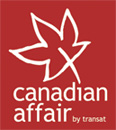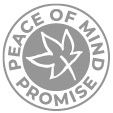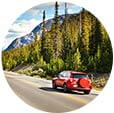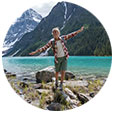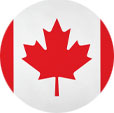Travelling to a new country is one of life’s greatest excitements – we dream of landing in a different climate, exploring a new landscape and immersing ourselves in a unique culture in the weeks leading up to a trip. But to make the most of your time away, it’s a good idea to prepare for your travels. Knowing how to plan a trip can be difficult, especially if you’re visiting somewhere totally new. This is sometimes the case for first-time travellers to Canada who aren’t sure what to expect in terms of weather, transport, paperwork or culture.
However, with a little forethought and some expert travel insider knowledge, you can arrive at your destination completely prepared and ready to start exploring. So check out these handy tips, that we’ve put together with help from some top travel bloggers, before you board your flight to Canada!
Planning ahead
Organise your travel documents

The first step to embarking upon that much-anticipated holiday is organising your papers. Yes, most holiday bookings are made online these days, and the majority of airlines offer everything from seat reservations to check-in on the web, but having a copy of all of the relevant documents is still an essential part of preparing a trip away. You never know when technology could have a temperamental moment! Having physical copies can help you to visualise your organisation, and can also save you trawling through your phone for the right email – particularly if your battery dies or you have no signal.
As well as printing off your boarding passes, flight itinerary, insurance and more, be sure to store it safely in a folder or plastic wallet. This helps to keep everything in one place so you aren’t rummaging around for your document at the front of the check-in queue. To make things even easier, you could stick colour-coded labels to the top of each document, with descriptors such as ‘boarding pass’ and ‘currency exchange’, just to make finding the correct piece of paper that bit quicker.
Find out the details

It might seem like it should go without saying, but one of the best ways to make your trip to Canada go without a hitch is by confirming all the transportation details in advance. From checking in online ahead of time to confirming baggage allowances, it’s much easier to get through the formalities quickly if you know what you need to do and where you need to be. Find out where you can park and which terminal you should be heading for, and check with your airport as to which zone your airline is likely to be situated in.
It is also well worth researching the facilities available at your airport – while award-winning sites such as Vancouver Airport offer everything from countless restaurants and five spas to cleaning services and shoe repairs, not all airports are so accommodating. So, if you think you’ll need a particular service while you await your flight, check in advance!
Get an ETA or visa
If you’re going on holiday to Canada, it is likely that you will need to apply for an eTA (Electronic Travel Authorisation) document. British Citizens don’t usually need a visa to visit Canada as a tourist for short periods, but you will need an eTA. If you have a different nationality or intend to travel for a longer period, it is important to check the entry requirements with the Canadian High Commission.
Send off for your eTA as soon as possible after you book flights – although they are usually approved within a matter of minutes, it is worth doing this while you have your trip at the front of your mind. The last thing you want to do is turn up at security only to realise you forgot to get one! eTAs only cost $7 CAD, and last for up to five years, or until your passport expires.
Book your seats

When it comes to long flights, comfort is paramount. This is something that Monica from The Travel Hack knows only too well. She advises, “When flying out to Canada, make sure you check in online and pre-book your seat in advance. I flew over there with two friends last year and we checked in online at the last minute, meaning we all had the worst seats. I don’t mind a bad seat on a short flight but on a long flight you want to sit with your friends and not be squished between strangers!” Online check-ins are now offered by most airlines, and you can view a floorplan of the cabin to choose seats based on your requirement – whether that be a window view or easy access to toilets.
This is also essential for travelling with children. Many airlines offer special adaptations for families, such as Air Transat’s policy for children flying with parents. Transat is committed to ensuring families are seated together on its aircraft, and to do so, parents should contact the Seat Selection Centre to request family requirements. There is also the Option Plus package, offering advantages within Economy Class to provide families with extra peace of mind.
Check flight regulations
With tightening security at most airports around the world, travel and luggage regulations are always being refined. One example of this that recently gained press attention was regarding laptops. Whereas they used to be allowed in the seatback pocket, rules now require laptops to be stowed under the seat or in the overhead compartments when not in use – like other hand luggage items. Flights departing from certain countries also forbid laptops to be kept in hand luggage. So, to avoid disruption, it is worth checking ahead with the rules stipulated by your departure and destination airports and countries before travel.
Organise transport

Of course, you haven’t quite reached your destination when your plane lands – there is also the matter of getting to your hotel in Canada, or in whichever country you are visiting. If you plan to book a transfer, consider doing so in advance by downloading a local taxi app such as Canada’s One Taxi and The Ride. With these tools you can search through various providers to find a convenient and competitively-priced transfer to get you from A to B with ease.
Or, better still, book a Canada car hire. Monica recommends doing so highly, saying, “My top tip for when you arrive is to hire a car. Canada is such a gorgeous destination and the best way to experience it is with an epic road trip.” This way, all you need to do when you arrive is pick up your vehicle and then you are free to explore your destination as you wish.
Packing and luggage
Double check your hand luggage

One rookie error that we’ve probably all made once in our lives is forgetting to double-check our hand luggage. Whether we’ve bought a bottle of water for the drive to the airport and left it in there by mistake, or forgotten to transfer that morning’s perfume into our hold luggage, it’s easy to keep restricted items in your carry-on by mistake. So, try to check your hand luggage at least three times – when you pack, before you leave for the airport, and just before going through security. This way you won’t have the stress of having items thrown away or holding up fellow passengers. Placing toiletries in your own zip-lock clear bags is another way to speed up the process at security significantly – meaning more time to peruse the duty-free!
Look into gear storage
Canada is the perfect adventure destination for skiing, snowboarding, mountain biking, climbing, and more, so it’s no surprise that millions of people visit the country on activity holidays every year. If you’re an avid snow sports fan, rider or climber, it’s likely that you’ll have a significant amount of gear to take with you. Though it’s easy to hire equipment in popular sporting destinations such as Whistler, sometimes it’s nice to bring the kit you’re used to.
If you decide this is the best approach for you, make sure to look into gear storage in advance. Check with your airline for their policy on large sporting items well in advance, and organise for your gear to be stored safely on the plane. If you’re staying in a hotel or considering hiring an RV, it’s also worth finding out what facilities are available so that you can keep your kit safe throughout your stay.
Pack a carry-on chill kit

Once you’re on the flight, it’s time to unwind. Flights to Canada can be long, and though the in-flight entertainment options are usually fantastic, travelling for long periods of time can always be tiring. So, turn your air travel into a time for relaxation by packing a carry-on chill-out kit. Whether you plan on sleeping for the entire journey or simply wish to indulge in a little pampering at several thousand feet, packing a relaxation kit in advance can make a huge difference. Ear plugs, a neck pillow and a sleeping mask are essentials for blocking out the chatter of fellow passengers, and many airlines supply these, such as the Transat comfort kit. But why not treat yourself with a moisturising face mask? After all, long journeys can be dehydrating for the skin, and you’ll want to feel your best for when you arrive!
Take your best camera

One item that you definitely do want to keep in your carry-on if you’re travelling to a beautiful destination like Canada is a camera. Alesha and Jarryd from the popular travel blog NOMADasaurus explain why a camera is their go-to item when visiting the country:
“Canada is one of the most beautiful places in the world, and after living there for 4 years and travelling from the west coast to the east coast, we love it. Make sure you take an amazing travel camera with you to capture all the stunning scenery you’ll encounter. And even though British Columbia is gorgeous, don’t miss the Maritime Provinces as well!”
By packing your camera in your carry-on, you can ensure that you’re capturing memories from the moment you land until the second you leave. Plus, who doesn’t want to get that perfect shot of the Rockies from the plane window?!
Pack for changeable weather

Many first-time visitors to Canada aren’t aware of the real diversity of climate that the country boasts. A winter in Toronto is very different from a winter in Vancouver! You might have a picture-perfect expectation of crisp sunshine or falling snow for your touch-down, but weather can change quickly, so make sure to pack a couple of items on your carry-on to account for all occasions.
Paul from A Luxury Travel Blog comments:
“Make a note of the likely weather – people often think of Canada as being a very cold place and, whilst that can be largely true, the climate is in fact very diverse. Of course, it is cold in winter and you will need to pack accordingly, but in summer – from around June to September – expect to take summer clothes as well as something to keep you warm (long sleeve shirts, etcetera), depending on where you’re heading and what you’ll be doing.”
Preparing for arrival
Download a currency converter

If you’ve never travelled to North America before, it’s easy to forget that USD and CAD are not the same currency, and the exchange rate between each currency and others are very different. Don’t make the mistake of going to Canada thinking you’ll be spending money at the same rate you would in the U.S. – the rates differ notably. To keep track of your spending, it’s also a good idea to download a currency converter app onto your phone. This way, you can check the price of items and activities before purchasing to check if they fit in your holiday budget, as well as working out how much you have to spend throughout your trip.
…And a translation app
While downloading a translation app might be a no-brainer when travelling to countries with a main language different to your own, many people visiting Canada forget this simple step. Most people in Canada do speak English, but in many areas – especially the province of Quebec – French is widely spoken. The vast majority of Canadians in cities such as Montreal and Quebec City are bilingual, but being able to translate a few phrases will not only help you get by day-to-day, it will also deepen your understanding of these areas’ rich history. So, whenever you are visiting an area with more than one main language, be sure to have a translation app close to hand!
Check the time zones

Most of us will automatically check the time zones for a country we are visiting before a holiday, but, when you live in a country with just one zone, it can be easy to forget that larger nations often have several. For example, these are the time zones across Canada:
Newfoundland Time (GMT – 2:30)
Atlantic Time (GMT – 3)
Eastern Standard time (GMT – 5)
Central time (GMT – 6)
Mountain Time (GMT – 7)
Pacific Time (GMT – 8)
So, if you’re visiting Montreal, the time difference will be very different to that on a holiday to Vancouver. Make sure to double check the time zone in your chosen destination before you fly, so you can work out what time you’ll land. Then, to avoid jet lag, try to sleep and eat at the times you will when you’re on holiday during the day of travel. This will make it much easier for your body to adjust.
